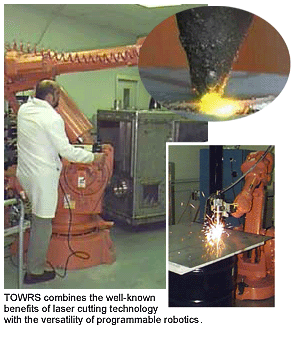|


 Put
aside the saws and blowtorches. Sometimes deactivation and decommissioning
work can actually be graceful. Bright light flashes and sparks fly
when a laser tool is used to cut through a contaminated glovebox.
The fireworks are directed by a large robotic arm that holds the laser-focusing
head and seems to glide along the surface of the box, effortlessly
slicing the thick metal into manageable pieces. Put
aside the saws and blowtorches. Sometimes deactivation and decommissioning
work can actually be graceful. Bright light flashes and sparks fly
when a laser tool is used to cut through a contaminated glovebox.
The fireworks are directed by a large robotic arm that holds the laser-focusing
head and seems to glide along the surface of the box, effortlessly
slicing the thick metal into manageable pieces.
Size reduction of radioactively contaminated gloveboxes is just one
use for a new remotely operated, programmable laser cutting system.
Called the transportable oversized waste reduction system (TOWRS),
it is different from previous laser cutting projects in that it combines
the well-known benefits of laser cutting technology with the versatility
of programmable robotics. The result is improved efficiency and utility
through flexible automation.
“It cuts stainless steel just like a knife through butter,”
said Edward H. Hohman, a technology developer and potential future
end user with Bechtel Nevada. “It is fast, and most importantly
to us, it can be operated remotely.”
Initial deployment of TOWRS, funded through the Accelerated Site Technology
Deployment (ASTD) initiative, is planned at Los
Alamos National Laboratory’s (LANL) Decontamination
and Volume Reduction System (DVRS) building site in early 2002. There
TOWRS will size reduce and decontaminate oversize metallic waste items.
The off-the-shelf, industrial 1.5-kW Nd/YAG laser is used to cut large
contaminated metal items into pieces small enough for packaging in
standard shipping containers. Most of the waste is transuranic (TRU),
contaminated with low levels of radioactive isotopes from weapons
production processes. Because of its size, this waste material cannot
be shipped, stored, or treated at existing facilities.
Some of the oversized waste that may be headed for LANL’s DVRS
is temporarily stored in 58 shipping containers at the Nevada Test
Site. These containers, some as long as 13 feet, are filled with bulky,
TRU-contaminated objects like gloveboxes, equipment racks, lengths
of metal piping, and even a metal desk. These containers and their
contents need to be size reduced at an off-site DOE facility so the
waste can be certified and shipped to the Waste Isolation Pilot Plant.
The versatility and precision of the system allows the technology
to address a variety of waste objects and also accurately remove high-contamination
areas, or “hot spots,” from otherwise low-level waste items.
Such selective size-reduction capability promises to save significant
amounts of money, since low-level waste items cost $3,000 per cubic
meter to dispose of, as compared to $50,000 for TRU waste.
“We developed the industrial laser configured with robots to
create a flexible work cell,” said Ross Muenchausen, principal
investigator for the TOWRS ASTD project at LANL. “We’ll
be able to process waste not only faster, but also more intelligently.”
The system actually utilizes two robotic arms, one to guide the laser
and the other to handle the cut pieces. Both robot arms and the laser
are remotely controllable from a self-contained trailer, where an
operator uses a control panel with computer monitors, connected to
cameras mounted within the containment structure. The high-power laser
output from the trailer is connected by fiber-optic cable to the cutting
head mounted on the robot, thus minimizing exposure of workers to
potentially hazardous laser radiation. This trailer is also transportable,
so the TOWRS laser system can be deployed at multiple DOE sites with
minimal capital costs.
The computer-driven laser system is quick and easy to set up. During
operations on a typical glovebox, it is capable of slicing along its
preprogrammed path at more than 7 feet of metal per minute, compared
to inches per minute for traditional manual size-reduction tools,
such as reciprocating saws, nibblers, and handheld torches. The TOWRS
laser cutting tool is expected to reduce the average time required
to size reduce a contaminated glovebox from one week to less than
one day.
TOWRS is as safe as it is fast. Remote operation minimizes the need
for workers to be exposed to contaminated environments and industrial-type
accidents. TOWRS laser cutting also generates less fumes and secondary
waste than the plasma torch. Terry Lucke, a project engineer from
Fluor Hanford
in Richland, Washington, said, “It’s a very clean operation.”
Operators also do not have to worry about using cumbersome manual
cutting tools while dressed in protective equipment. That slow, tedious
method is inefficient and subjects the worker to hazards such as puncture
wounds and repetitive motion injuries. TOWRS operates with much less
risk. “By deploying TOWRS, you’re going to essentially eliminate
worker fatigue and inhalation exposure during the cutting operation,”
Muenchausen added.
The system was designed and constructed by a team from Fluor Hanford
and LANL, while Bechtel Nevada
is providing overall project management. Project staff are currently
developing operating procedures, performance testing the integrated
system at the vendor’s (GSI Lumonics) facility, and analyzing
cost savings.
During the planned deployment at LANL, TOWRS will assist in the size
reduction of hundreds of oversize TRU waste boxes. TOWRS will likely
be used at Hanford to remove stainless steel cell liners and perhaps
for similar oversized waste at Rocky
Flats. Depending on the availability of future funding for TOWRS
deployment, this laser may be called on to process the abundance of
material that exists throughout the DOE complex.
The future looks bright for the TOWRS traveling laser show.
For more information, visit http://www-emtd.lanl.gov/laser/cutting.html
or contact Ross Muenchausen, LANL, (505) 667-0391, rossm@lanl.gov.
|